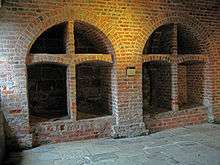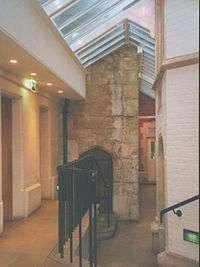Buttery (room)
.jpg)



A buttery was a service room in a large medieval house in which barrels, bottles, or butts of alcoholic drink were stored, and from which they were served into the Great Hall. The "butler" was anciently the household officer in charge of the buttery, and possibly for its provisionment (i.e., the sourcing and purchasing of wine), and was required to serve wine to his lord and guests at banquets. In the royal household such officer was termed the "Marshal of the Buttery" and was often a post discharged under the feudal land tenure of grand serjeanty.[1] In less important households such an officer was termed the yeoman of the buttery.
Etymology
The words "buttery" and "bottle" derive from mediaeval French word botte and its diminutive bouteille (meaning "barrel" and "small barrel", respectively), which in turn are derived from the mediaeval Latin terms buttis (meaning "a barrel") and butticula.[2][3][4][5]
Location
The buttery was situated to one side of the screens passage, which sectioned off the low end of the Great Hall. The screens passage generally had two or three doors on the side opposite its entrances into the Great Hall, which led, respectively, to the buttery, kitchen, and pantry, each of which formed separate household departments.
Function
The buttery's principal function was storage of wine and its preparation for serving. Candles were also dispensed from the buttery as was beer to those lower members of the household not entitled to drink wine.[6] Today in colleges in Cambridge, Dublin, and Oxford, drinks are served from the "Buttery Bar".[7] The buttery generally had a staircase to the beer cellar below.[8] The wine-storage area of the buttery, in keeping with the higher value of its contents, was often more richly decorated to reflect the higher status of its function.[9]
Decline
From the mid-17th century, as it became the custom for servants and their offices to be less conspicuous and sited far from the principal reception rooms, the Great Hall and its neighbouring buttery and pantry lost their original uses. While the Great Hall often became a grand staircase hall or large reception hall (as at Powderham Castle in Devon), the smaller buttery and pantry beyond the screens passage were often amalgamated to form a further reception or dining room.
Distinguished from the dairy
The buttery should not be confused with the household department which stored and processed milk and its by-products such as butter and cheese, termed the "dairy". The English word "butter", as the dairy product, derives from a different etymological source from "buttery" the wine-store, namely from Old English butere, from Latin butyrum, from Greek boutyron, deriving ultimately from bous, "cow".[10] Kaufman proposed an apparently erroneous derivation: "Cows were also kept near the castle to provide milk and milk by-product, which were processed in the castle buttery".[11]
References
- ↑ The manor of Kingston Russell in Dorset was held by the grand serjeanty of being the king's Marshall of the Buttery
- ↑ Buttery. Collins Dictionary of the English Language.
- ↑ Bottle. Collins Dictionary of the English Language.
- ↑ Botte. Larousse Dictionnnaire de la Langue Francaise. Paris: Lexis. 1979.
- ↑ Bouteille. Larousse Dictionnnaire de la Langue Francaise. Paris: Lexis. 1979.
- ↑ Girouard, p34
- ↑ Durant, David N. (1996). ""Buttery" - historical terms from the sixteenth century to the present". Where Queen Elizabeth Slept & What the Butler Saw.
- ↑ Girouard, p. 34
- ↑ Girouard, p35.
- ↑ "Butter". Collins Dictionary of the English Language. London. 1986.
- ↑ J. E. Kaufmann; H. W. Kaufmann & Jurga, Robert M. (2004). The Medieval Fortress: castles, forts and walled cities of the Middle Ages. p. 53. Such products were processed in the dairy, not the buttery.
Bibliography
- Girouard, Mark (1978). Life in the English Country House. Yale University Press. ISBN 0-300-02273-5.